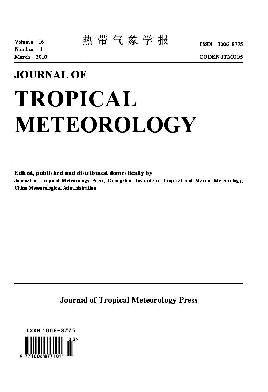-
Abstract:
Four landfalling typhoon cases in 2005 were selected for a numerical simulation study with the Global/Regional Assimilation and Prediction System (GRAPES) model. The preliminary assessment results of the performance of the model, including the predictions of typhoon track, landfall time, location and intensity, etc., are presented and the sources of errors are analyzed. The 24-hour distance forecast error of the typhoon center by the model is shown to be about 131 km, while the 48-hour error is 252 km. The model was relatively more skilful at forecasts of landfall time and locations than those of intensity at landfall. On average, the 24-hour forecasts were slightly better than the 48-hour ones. An analysis of data impacts indicates that the assimilation of unconventional observation data is essential for the improvement of the model simulation. The model could also be improved by increasing model resolution to simulate the mesoscale and fine scale systems and by improving methods of terrain refinement processing.
-
References
|
[1]
|
China Meteorological Administration. Special Reports onImportant Meteorological Information [R]. 2005: NO.106, 134,135, 141. |
|
[2]
|
FUKADA E. A Review of the Joint Typhoon WarningCenter 2006 Tropical Cyclone Season [C]. 61stInterdepartmental Hurricane Conference, March 5-9, 2007,New Orleans, LA, U.S.A. |
|
[3]
|
Annual Report on Activities of the RSMC Tokyo - TyphoonCenter 2005 [EB/OL].http://www.jma.go.jp/jma/jma-eng/jma-center/rsmc-hp-pub-eg/annualreport.html. |
|
[4]
|
LV Guo-chen. On the Track Forecasting of Typhoons inNorthwest Pacific 2005 [C]. Proceedings of Seminar onMeteorological Science and Technology Across the TaiwanStraits 2006. |
|
[5]
|
DUAN Yi-hong, YU Hui, WU Rong-sheng. Review of theresearch in the intensity change of tropical cyclone [J]. ActaMeteor. Sinica, 2005, 63(5): 636-645. |
|
[6]
|
YE Cheng-zhi, PAN Zhi-xiang, CHENG Rui, et al. Thenumerical research of the primary mechanism of the landfallreinforcement of typhoon Rananim based on AREM [J]. ActaMeteor. Sinica, 2007, 65(2): 208-220. |
|
[7]
|
CHEN De-hui, YANG-Xue-sheng, ZHANG Hong-liang, etal. Strategy for designing a non-hydrostatic multi-scalecommunity model dynamic core [J]. Quart. J. Appl. Meteor.,2003, l4(4): 452-461. |
|
[8]
|
TAN Xiao-wei, CHEN De-hui, ZHANG Qing-hong. Animpact study of a new type of data of adaptive or targetingobservation on typhoon forecast [J]. J. Trop. Meteor., 2006,22(1): 18-25. |
|
[9]
|
YE Cheng-zhi, OUYANG Li-cheng, LI Xiang-yu, et al.Validation of 2005 heavy rain events over the Yangtze Riverbasin forecast by GRAPES [J]. J. Trop. Meteor., 2006, 22(4):393-399. |
|
[10]
|
DING Wei-yu, WAN Qi-lin, YAN Jing-hua, et al. Impactof the initialization on mesoscale model prediction in southChina [J]. J. Trop. Meteor., 2006, 22(1): 10-17. |
|
[11]
|
WAN Qi-lin, HE Xi-cheng. The structure of tropicalcyclone by tovs and its application in numerical weatherprediction [J]. J. Trop. Meteor.(English edition), 2002, 8(2):218-224. |
|
[12]
|
GUO Qiao-hong. The application and verification of T213and ECM model products in the forecast of Typhoon Matsa [J].J. Zhejiang Meteor., 2006, 27(2): 7-15. |
-
-
-

















 粤公网安备 4401069904700002号
粤公网安备 4401069904700002号
 DownLoad:
DownLoad: